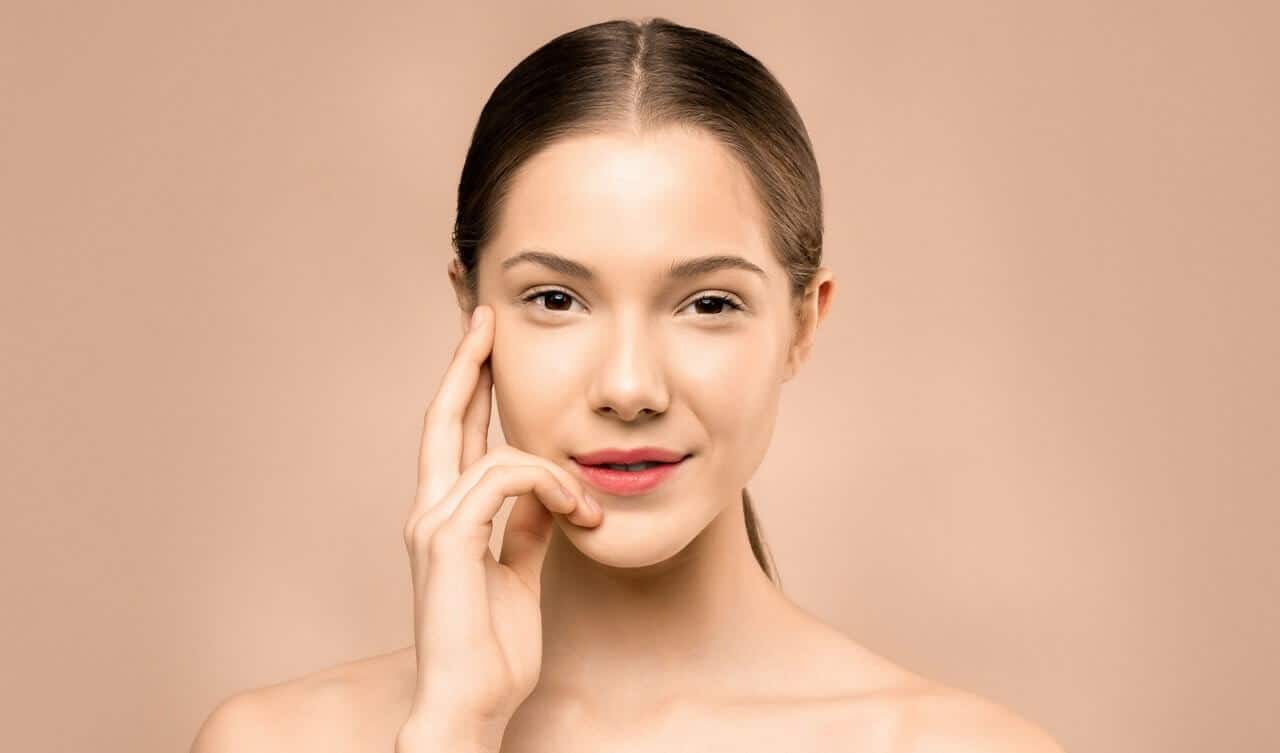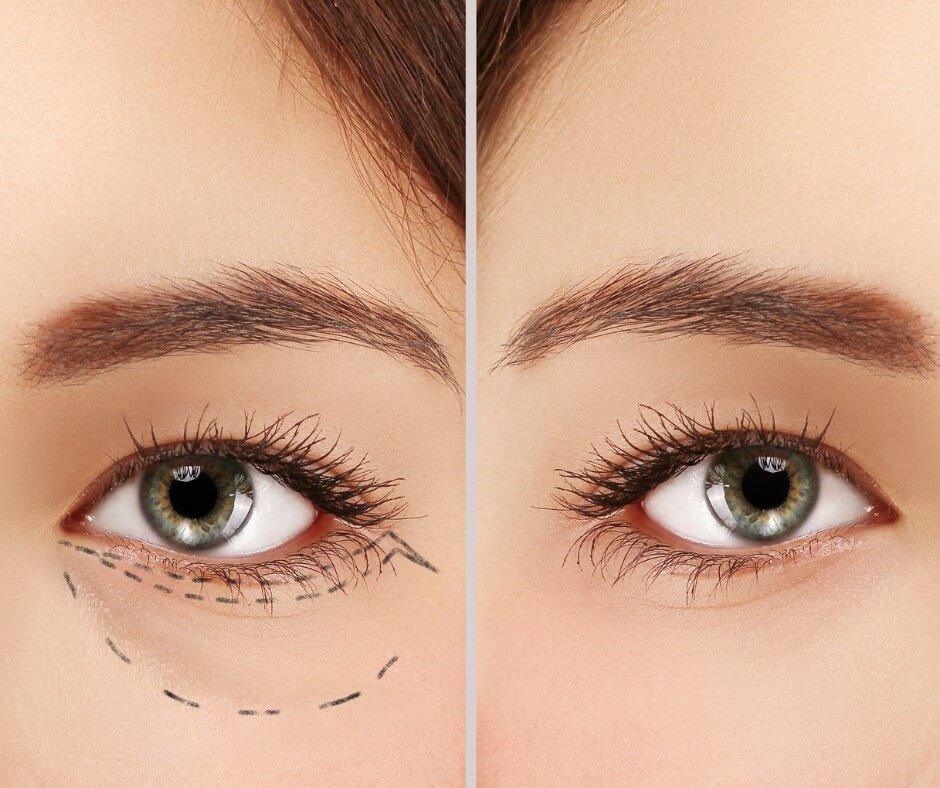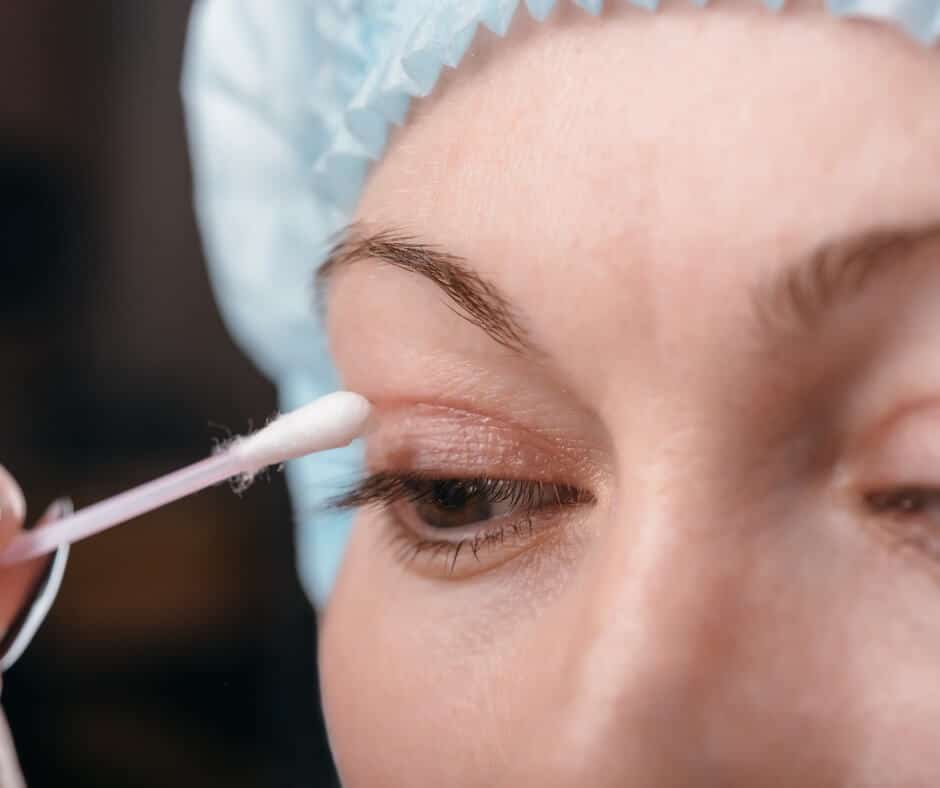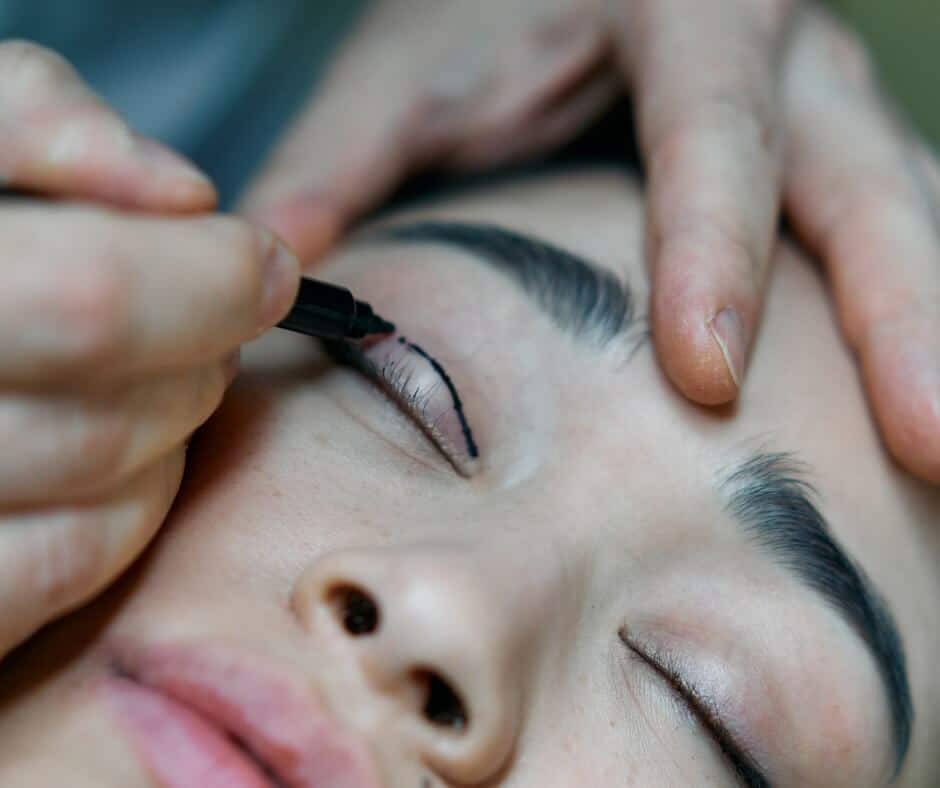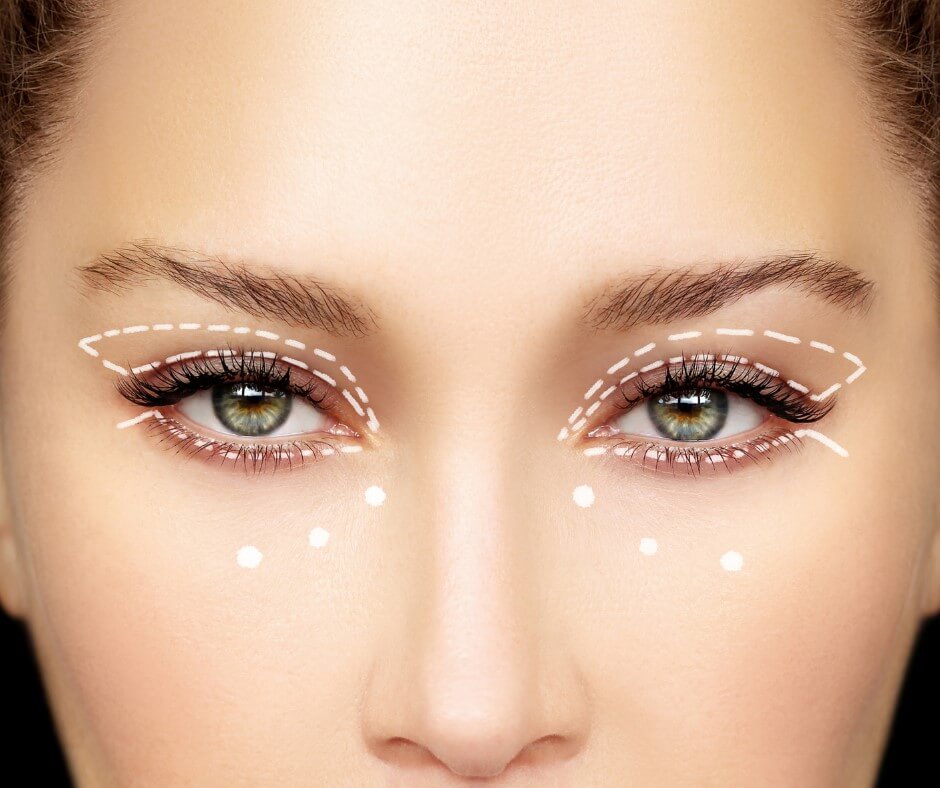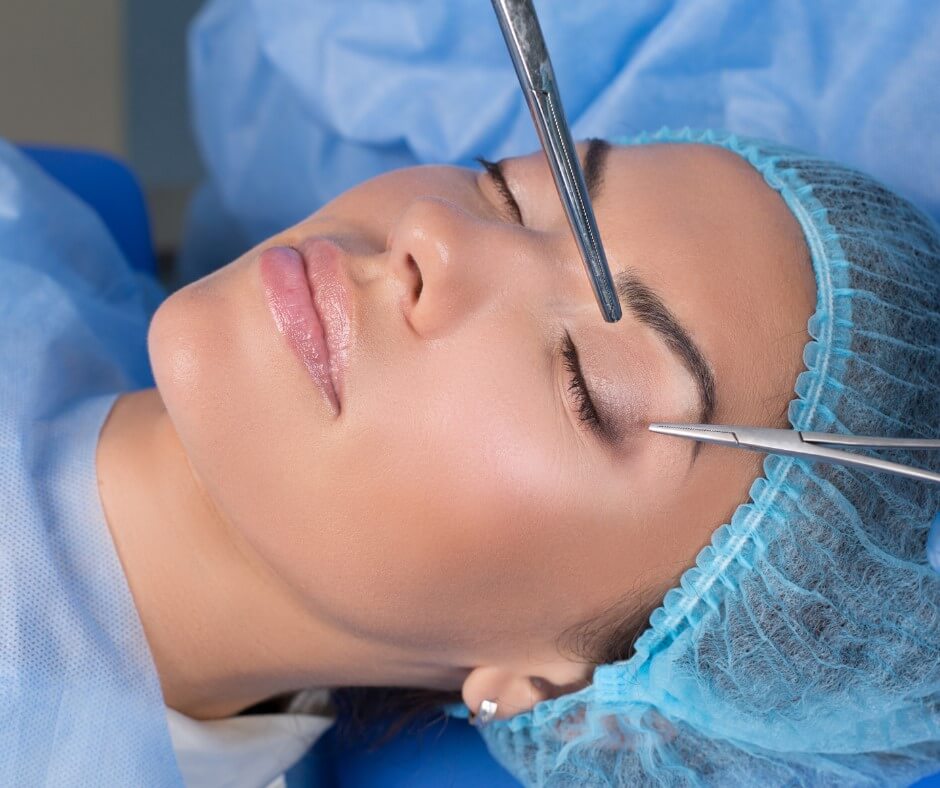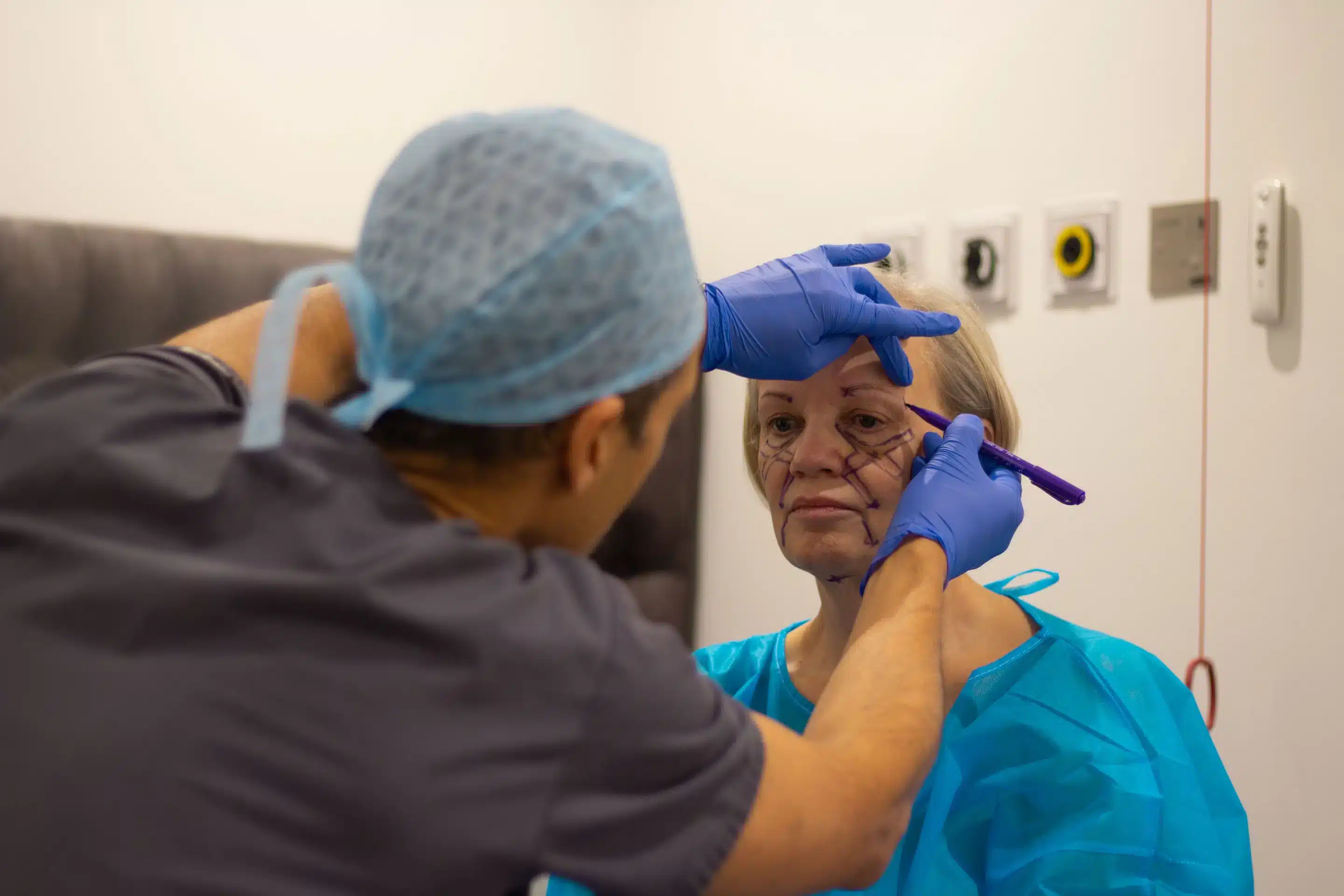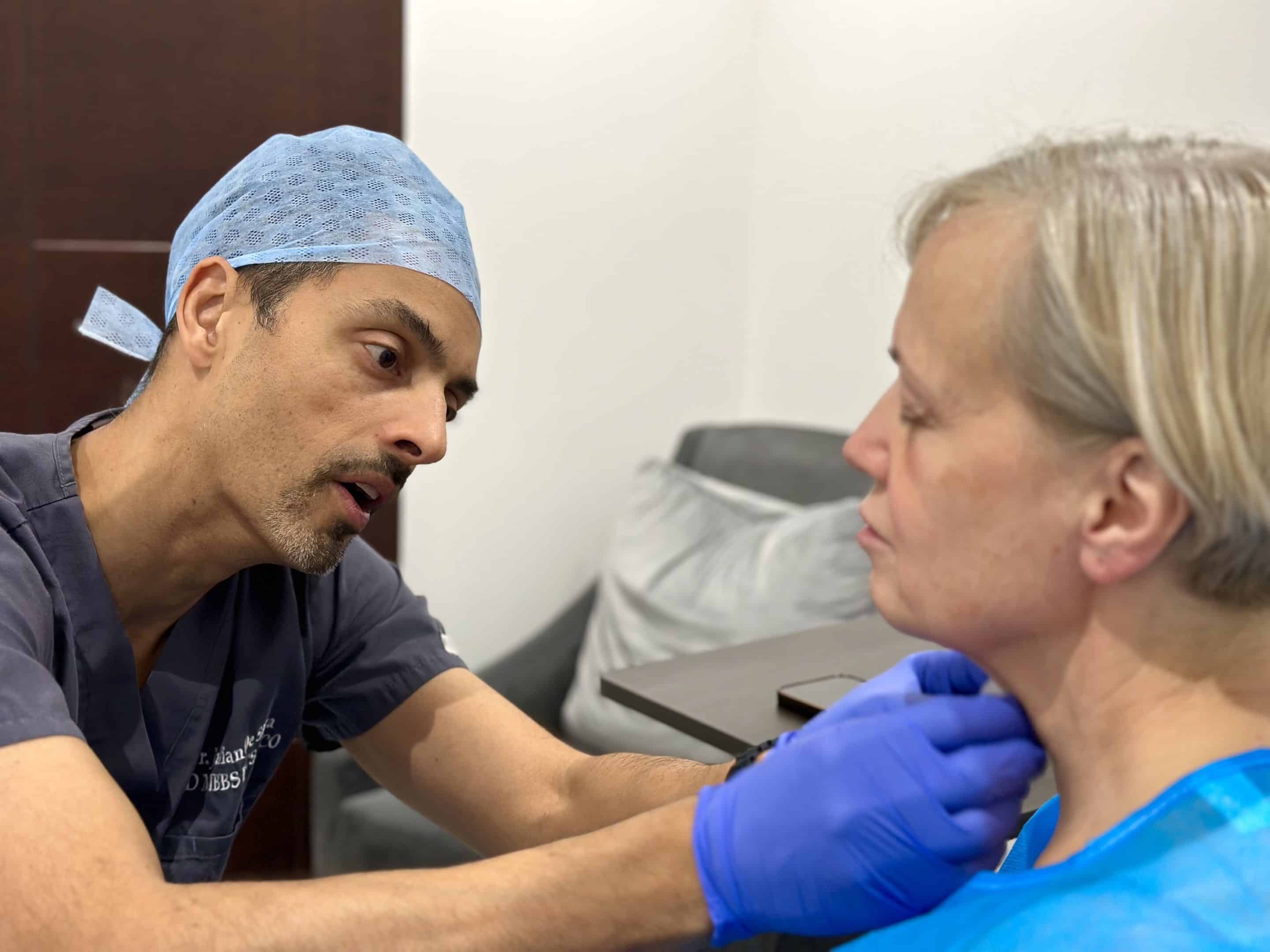A plastic surgeon helps enhance your eyes and make them look more proportionate with the rest of your face.
A plastic surgeon operates on your eyelids to enhance your appearance. They can also remove excess skin that often causes or contributes to issues like blurred vision, dry eyes, thyroid eye disease, watery eyes, and a seemingly protruding eye socket.
But how exactly do you know if an eyelid cosmetic surgeon is the right one for you? Are there any questions you must ask them?
In this article, I will talk about the questions you should ask your cosmetic surgeon before getting blepharoplasty or eyelid surgery.
What is an eyelid cosmetic surgeon called?
There are two types of doctors who operate on eyelids: an ophthalmologist or an oculoplastic surgeon.
An ophthalmologist operates on most patients mainly due to medical reasons. On the other hand, oculoplastic surgeons operate on patients mainly because of cosmetic reasons.
I, Dr. Julian De Silva, am a plastic surgeon who specialises in the face. Hence, I have performed a lot of eyelid surgeries.
Is eyelid surgery worth the money?
Yes, it is worth the full cost, especially if your eyelid problems are causing cosmetic and medical concerns.
Reasons why eyelid surgery is worth your money
Here are the reasons why the said surgery is worth your money:
Elimination of extra fat pockets
Elimination of extra fat pockets that cause the appearance of under-eye bags is one of the numerous advantages of blepharoplasty.
These bags are frequently misdiagnosed as the consequence of allergies, a lack of sleep, or exhaustion. However, in many cases, this is not the case. These bags are frequently caused by lower eyelid fat prolapse.
Removal of excess skin
Excess skin or excess tissue on the upper eyelid can frequently be draped over the eyelashes in extreme cases. This drooping might be inherited, age-related, or the effect of years of sun exposure that leads to fine wrinkles and bad lifestyle choices. Sagging upper eyelids are particularly alarming since they can impair vision.
A solution to vision problems
In addition, if you find yourself bending your head to see correctly, this might also be an indication that you need upper lid blepharoplasty to correct and enhance your eyesight.
The removal of extra skin from the top eyelids via an upper blepharoplasty treatment can help enhance both your eyesight and your look.
Looking younger
Blepharoplasty surgery also revitalises your look and brings back a more youthful appearance. The eyelid lift, fat reduction, and sculpting of the eyelids, unlike anything else, can produce an alert and refreshed appearance.
Who is the best eyelid plastic surgeon in the UK?
There are many excellent eyelid cosmetic surgeons in the UK.
One of them is me, Dr. Julian De Silva. With over twenty years of experience under my belt, I can deliver the results you need and want.
Furthermore, I have operated on celebrities and other prominent figures over the years. My Harley Street clinic also has state-of-the-art equipment that helps me administer safe and effective eyelid procedures.
Eyelid surgery (Blepharoplasty) consultants
The right doctor must have to meet certain criteria.
The right eyelid surgery or blepharoplasty consultant surgeon or doctors must have the following qualifications:
1. Proper education and training
The cornerstone of a plastic surgeon’s success is education and training. A top-tier plastic surgeon has a medical degree and has completed a residency in plastic surgery.
You can see Dr. Julian De Silva’s awards and medical publications here.
2. A comprehensive collection of surgical procedures including those treating excess skin
Plastic surgeons must have extensive experience in performing surgery on the face. They also provide alternatives to surgery like non-surgical necklifts and non-surgical nose jobs, which can improve a patient’s look and supplement the outcomes gained through surgical procedures.
Moreover, in the field of plastic surgery, there is no alternative to experience. Years of expertise have allowed surgeons to hone their surgical abilities and operate on thousands of patients. A skilled surgeon will decide whether you are a good candidate for eyelid surgery and will work with you to set realistic goals and expectations.
3. Use of the latest cutting-edge techniques including those used for the upper eyelid and lower eyelids
Leading surgeons are always researching the most recent breakthroughs in their area. They frequently upgrade their surgical equipment and are dedicated to improving the patient experience from start to end.
The cosmetic surgeon you pick should go through the procedures and equipment he utilises for the treatment (e.g. ptosis surgery) you want, as well as why those approaches are ideal for you.
4. An impressive portfolio of results
Top plastic surgeons are not afraid to show off their work. You should be able to see a lot of before-and-after images of the surgery you’re thinking about getting. Some doctors even give video clips that might help people learn more about the surgery they offer.
You can see before and after pictures of my eyelid surgery or blepharoplasty patients here.
5. Outstanding patient reviews and testimonials
Excellent patient feedback indicates a plastic surgeon’s skill. You should examine reviews on Google, Facebook, and other social media sites before choosing a surgeon. Testimonials are particularly beneficial since they give important information regarding a surgeon’s bedside manner and aftercare assistance.
You can see testimonials or reviews from Dr. Julian De Silva’s patients here. You can also check Dr. Julian De Silva’s patient video testimonials here.
What does it involve?
When both the upper and lower eyelids are lifted at the same time, the procedure takes around two hours.
Before we do the operation, you will be given sedation anaesthesia. Sedation works well for eyelid surgery because it is safer than general anaesthesia.
Upper Eyelid Surgery
If you have all four eyelids done, I will likely start with upper eyelid surgery. Typically, I will cut along the natural lines of your eyelids.
I will then use these cuts to separate the skin from the underlying tissue and remove excess fat and excess skin. I will then use extremely thin stitches to repair the wounds.
Lower Eyelids Surgery
Lower eyelid surgery or lower lid blepharoplasty can be performed using one of many procedures. To remove excess fat, I usually create an incision inside the natural fold of your lower lid. That cut will be hidden.
Another approach is to make an incision along the lash line. I can remove extra skin, loose muscle, and fat through that incision. After a short while, the cut line fades.
The stitches or suture strips on your upper eyelids will be removed after a few days or a week. Depending on the procedure employed, the lower lid may or may not require sutures.
You also have to wait for your doctor’s signal before wearing contact lenses after blepharoplasty recovery. If you use contact lenses, ask your doctor for alternatives.
Remember, you cannot resume regular exercise on the same day as your surgery. You must also avoid smoking, and doing strenuous activity for several weeks or until you see the final result.
Moreover, if you have dark skin and a healthy weight, you must still use sunscreen and dark glasses, follow a skincare routine, gently clean your face, and live a healthy lifestyle to avoid complications and maintain the results of the surgery.
Side effects to expect
The surgery has some side effects including discomfort and swelling.
The following are the most common side effects of blepharoplasty surgery:
1. Discomfort
It is common to feel some discomfort after your surgery. The level of discomfort is often determined by a number of factors, including the scope of your operation. To relieve discomfort, prescription medicine may be used for up to a few weeks.
2. Swelling
Puffiness and swelling are common after blepharoplasty. Over-the-counter medicine or antibiotic ointment can help reduce swelling. Cold compresses can also be carefully administered in 20-minute intervals.
3. Scarring
Some scarring is to be expected after eyelid surgery. A knowledgeable doctor would take extra precautions to minimise scarring. Scarring usually fades with time.
What could go wrong
While eyelid surgery is a relatively common treatment, it is a surgical procedure.
As with other procedures, there are certain risks (more like a small risk) involved. However, things will only go wrong if you go to an inexperienced doctor.
Here are some of the things that could go wrong if you go to the wrong surgeon:
- Occasional blurry vision or seeing double
- Eyes that might not look perfectly aligned
- Bruising under the skin that should fade over a few weeks
In isolated instances, the surgery could result in more serious issues like:
- A lower eyelid sagging away from the eye
- Potential infection
- Formation of blood clots
- Adverse reactions from local or general anaesthesia
Steps to Take in Case of Complications
Should you notice increasing pain, if the area around your stitches becomes increasingly red, swells, starts to bleed excessively or emits a peculiar discharge, or if you feel feverish or have any worries regarding your recovery, it’s essential to reach out to your healthcare professional promptly.
What to Expect During Your Initial Meeting
During your first meeting, there’ll be a comprehensive discussion with your physician.
Here’s a rough idea of the matters you’ll be discussing during your eyelid surgery discussion:
- Your goals for the surgery
- Health background
- Any medications, vitamins, or natural supplements you’re taking
- Consumption habits like alcohol, smoking, and any other substances
- Past surgical experiences, especially any related to upper or lower eyelid corrections
Use this opportunity to raise any queries with your cosmetic specialist. It might be helpful to jot down your questions in a note beforehand.
Feeling a bit anxious or nervous is completely natural, whether it’s about the anticipated results or the procedure itself. Always share your feelings with your specialist.
How Much Time Does Eyelid Correction Require?
Typically, the surgery spans one to two hours.
Opting for an adjustment on either the upper or lower eyelids alone might take about an hour. If you’re adjusting both, anticipate roughly two hours. Including additional procedures, like a brow lift, will extend this duration.
Concerned About Post-Surgery Appearance?
It’s a prevalent concern among cosmetic surgery aspirants to fear appearing too altered post-surgery. With eyelid adjustments, this sentiment is often heightened due to the eyes’ prominence.
However, eyelid correction encompasses a range of methods. In the hands of an expert, the result can be refreshingly youthful yet authentically you.
Dr. Julian De Silva stands out in the world of oculofacial cosmetic surgery, having also extensively trained in ophthalmology. He’s contributed to medical literature concerning eyelid adjustments. Marrying his focus on facial and eye aesthetics with an artistic touch ensures that his patients enjoy results that are both stunning and natural.
What is Eyelid Surgery?
Eyelid surgery, commonly known as blepharoplasty, addresses either the upper, lower, or both eyelids. Dr. De Silva has mastered this surgery to fix issues like swollen eyelids, excess skin, or saggy skin surrounding the eyes. Precision is key in this procedure, as even subtle alterations are noticeable – a slight variation between the left and right side can be evident.
Check out this video where Dr. Julian De Silva explains the intricacies of blepharoplasty.
How Might My Eyes Appear Post-Surgery?
A skillfully executed blepharoplasty results in eyes that seem refreshed and alert, but shouldn’t significantly alter their inherent shape unless you want that. A seasoned surgeon considers your individual facial features, aspirations, and anticipations while performing the operation, employing a variety of methods to reach the envisioned outcome.
Several techniques might involve rearranging or extracting surplus skin and fat, concealing any marks within the eyelid or along the eye’s creases.
The end goal is a rejuvenated appearance that exudes vibrancy, freshness, and most crucially, remains unmistakably you.
My journey and recuperation following eyelid surgery.
Why Should I Get Blepharoplasty?
Are you self-conscious or unhappy about puffy eyelids, having one eyelid puffier than the other, or excess skin or fat around your eyes? Do people often ask if you’re tired? Do you have trouble using or wearing makeup because of your eyelids? A blepharoplasty might be the right option for you. The eyes are often the first thing we notice of another person, and self-consciousness in this area can have effects on our personal lives and relationships.
Blepharoplasty can be performed on younger people who are taking preventative measures when it comes to ageing, or because they have a genetic trait that causes puffiness around the eyes. Those who are older may have blepharoplasty because they are not happy with how age has affected their eyelids.
With good surgery and an expert surgeon, your friends and family members will not be able to tell you have had eyelid surgery. Although, they may comment on how much younger, alert, or confident you look!
Dr. De Silva customises his treatments based on your unique facial characteristics, and even patients who have had a substantial rejuvenation have been surprised that family and friends have not noticed they have had surgery.
If you are considering blepharoplasty, contact Dr. De Silva and the team at London Facial Plastic Surgery on Harley Street. As a cosmetic surgeon specialising in the facial area, Dr. De Silva provides the best in patient care and experience.
Are You a Good Candidate for Eyelid Surgery?
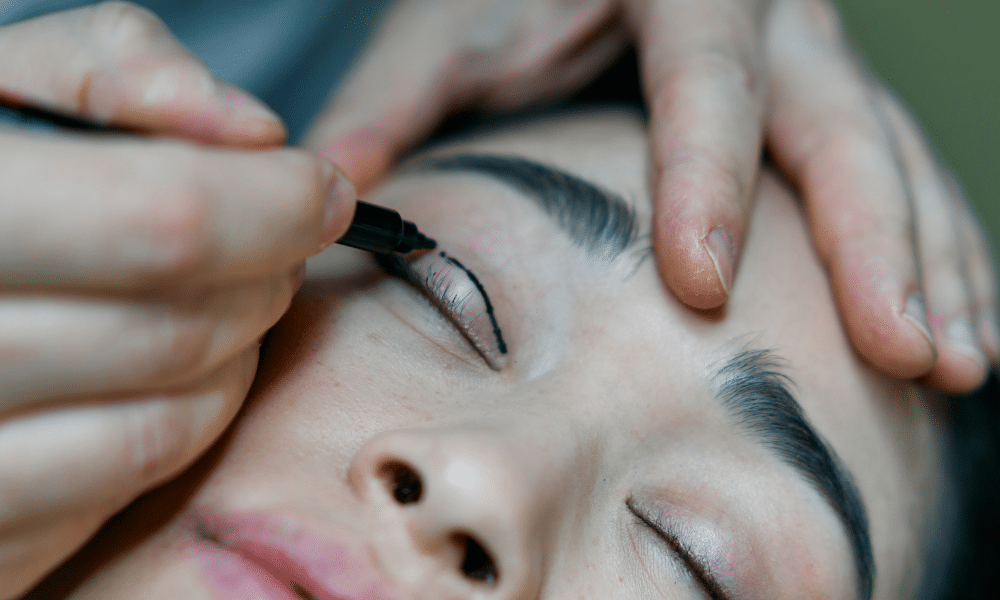
Eyelid enhancement can address both aesthetic and functional issues.
Whether it’s for sagging eyelids or obstructed vision, understanding if you’re a suitable candidate for this surgery is crucial.
Eyelid enhancement, commonly known as eyelid correction or simply an eye lift, is a significant operation. It’s vital to ensure you’re the right fit for the procedure to avoid potential complications.
In this piece, I’ll delve into the world of eyelid enhancement, its advantages, and who’s best suited for it. We’ll also explore what experts typically consider when determining if an individual is apt for this surgery.
Understanding Eyelid Enhancement
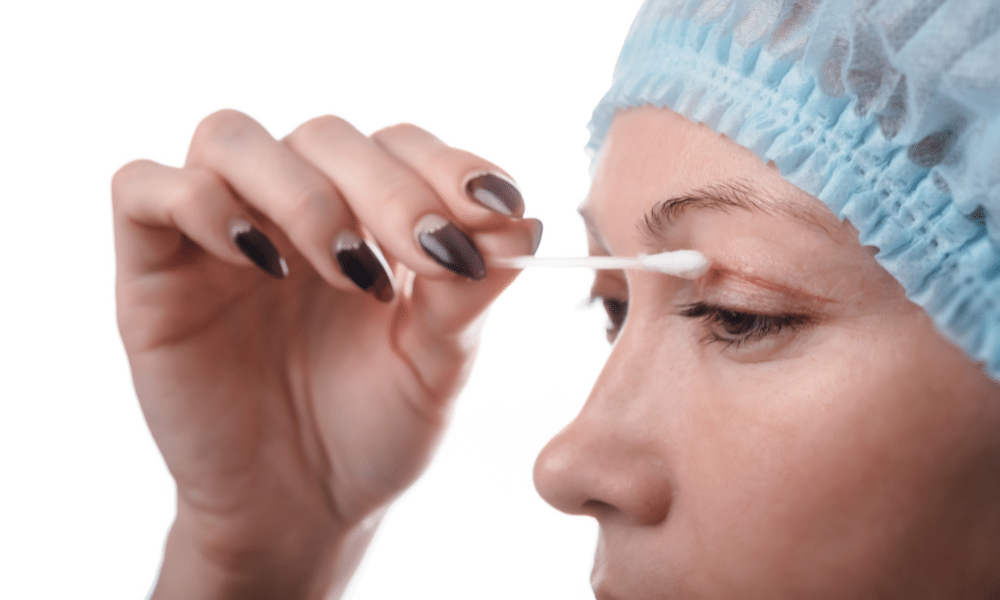
Only trust a seasoned eyelid specialist for your procedure.
An eye lift, widely referred to as blepharoplasty or eyelid correction, encompasses specific surgical methods.
Given the intricate nature of an eye lift, the choice of your practitioner is paramount. It’s advised to engage with a top-tier cosmetic specialist in the field.
First and foremost, ensure your chosen specialist is board-certified. They should also possess ample experience in conducting eyelid surgeries. This ensures you’re in safe hands, aiming for optimal outcomes.
Many opt for eyelid enhancement due to problems commonly tied to the natural ageing process.
As years pass, our body’s collagen and elastin reservoirs diminish. These elements bestow our skin with firmness, framework, and suppleness.
A lack of these vital proteins means our skin starts losing its youthful vibrancy. Ageing markers then become increasingly evident, sometimes making individuals appear older than they truly are.
Issues like wrinkles, crow’s feet, under-eye bags, and dark circles are common culprits. However, the silver lining is that while ageing is inevitable, there are treatments to alleviate its visible signs.
Interestingly, eyelid enhancement can be coupled with other treatments such as laser treatments and eyebrow elevation. The additional procedures largely hinge on your surgeon’s guidance. If you’re curious about which treatments might benefit you, feel free to schedule a consultation with me.
Reasons to Consider Eyelid Surgery
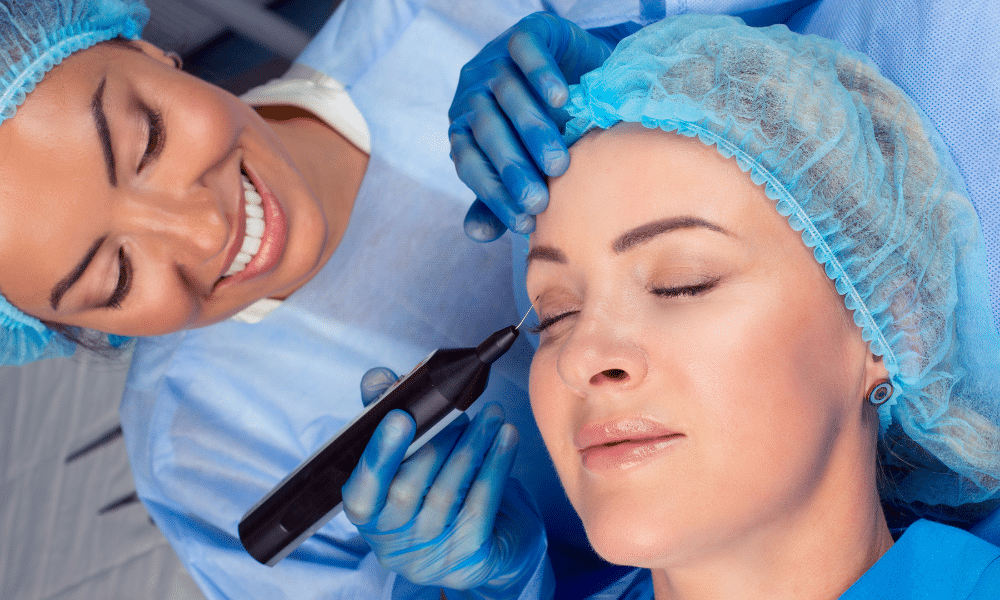
People go through eye lifting surgery because of cosmetic and medical reasons.
Many opt for eyelid enhancement procedures for both aesthetic and health-related reasons. Here’s an exploration of the motivations behind choosing such surgeries:
Cosmetic Reasons

Patients often have eye lifting surgery due to cosmetic issues.
Frequently, individuals choose eyelid enhancements to refine their look. From achieving a more awake demeanor to countering the signs of ageing, eyelid adjustments can be a solution to multiple cosmetic concerns.
1. Under-Eye Puffiness
While many believe that a lack of rest results in puffy eyes, that’s not always the primary cause. The forward movement of fat from the eye socket, termed lower eyelid fat prolapse, often leads to pronounced under-eye bags. Ageing, an inevitable process, exacerbates this. Through eyelid adjustment, surgeons can remove or reposition this protruding fat, giving the eyes a more rested appearance.
2. Dark Under-Eye Shadows
AContrary to assumptions, it isn’t just fatigue or bruises that cause under-eye shadows. They often result from the play of light and shadows due to under-eye hollows or puffiness. Age-related weakening of the tissue around the eyes can accentuate this. With eyelid surgery, the appearance of these shadows can be minimized, leading to a fresher look.
3. Crow’s Feet

Crow’s feet are a common issue that can be solved by blepharoplasty or eyelid surgery.
The little lines that radiate from the eye’s outer corners, known as crow’s feet, are often a hallmark of ageing. These lines emerge from a combination of age and habitual facial expressions. As skin matures, it loses its elasticity and resilience, making such lines more pronounced. Eyelid surgery can aid in tightening this area, making these lines less noticeable.
4. Tired or Unwelcoming Appearance
How one is perceived can be impacted by facial features. Features like under-eye bags or crow’s feet can give an impression of perpetual fatigue or even irritability. Eyelid enhancements can counter these signs, leading to a more approachable and lively appearance.
5. Premature Ageing
Some individuals find themselves looking more mature than they actually are. This often impacts their self-esteem. Factors like under-eye bags can add years to one’s appearance. An eyelid adjustment can potentially turn back the clock, rendering a more youthful and vibrant visage.
In essence, eyelid surgery can be transformative, offering a renewed look that aligns more with how individuals feel on the inside. If these concerns resonate, consulting with a seasoned eyelid specialist would help a lot.
Medical Reasons
There are occasions when eyelid adjustments aren’t just for aesthetic purposes but for health concerns. Eyelid surgery can offer solutions to a range of medical challenges.
1. Impaired Vision
A prevalent health issue that eyelid surgery addresses is the hindrance to one’s line of sight. While conditions like astigmatism are frequent culprits, surplus skin from the upper eyelids can sometimes exacerbate vision difficulties. Such excessive skin can potentially drape over the eyes, impacting daily tasks such as driving. A successful eyelid procedure can alleviate this, leading to unobstructed vision.
2. Eye Irritation
Excessive eyelid skin can not only block vision but also be a source of constant itchiness. The natural response is to rub the eyes, but with the added skin, this can lead to further irritation, manifesting as redness or swelling. For those wearing spectacles or contacts, this excess skin can intensify the discomfort, making prolonged wear challenging. A well-executed eyelid adjustment can remedy this, offering relief.
3. Forehead Strain
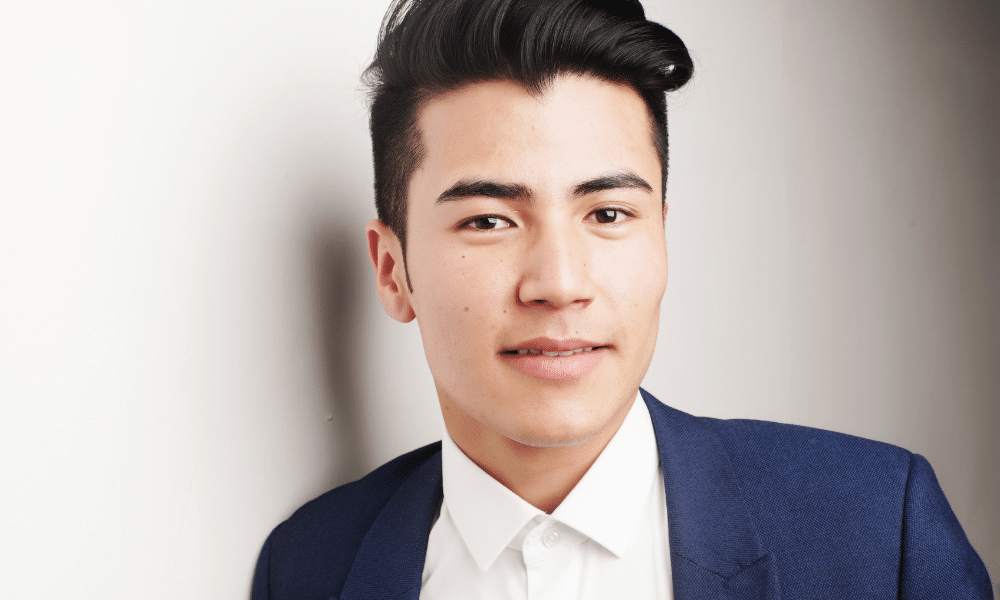
Droopy eyelids can lead to forehead discomfort.
Drooping eyelids don’t just affect the eyes but can place stress on the forehead. With sagging eyelids, the forehead muscles often overcompensate to aid eye movement. Over time, this continuous effort tires these muscles, leading to discomfort or even pain. Eyelid surgery can alleviate the burden on these muscles, bringing about a more comfortable day-to-day experience.
4. Dry Eyes
Drooping eyelids can potentially lead to a condition known as dry eye syndrome, where the eyes aren’t adequately lubricated due to reduced tear production. Tears play a pivotal role in maintaining eye health by ensuring a smooth eye surface and flushing out potential irritants. As age advances, especially after the age of 50, tear production typically diminishes. Proper eyelid surgery can mitigate this, aiding in averting the onset of dry eyes.
5. Excessive Tear Production
Conversely, sagging upper eyelids can also lead to persistently watery eyes, a condition often linked with the aforementioned dry eye syndrome. While tears are essential for eye health, an overabundance can be counterproductive. The weight of sagging skin pressing against the eye can lead to the pooling of these excess tears, which then overflow. An expertly done eyelid surgery can address this, balancing tear production and ensuring eye comfort.
Are You Suitable for Eyelid Surgery?
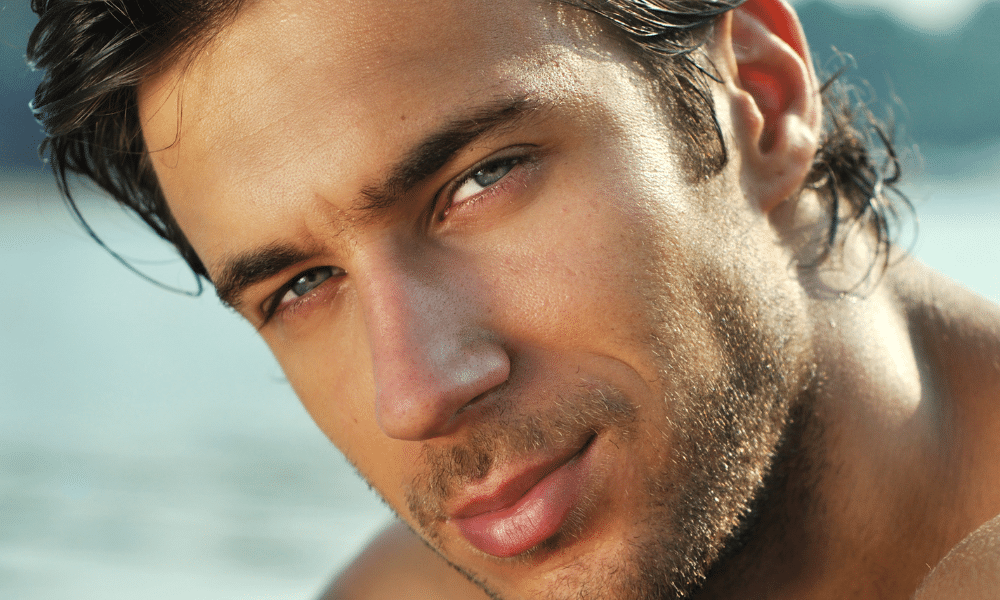
You need to be an ideal candidate to have eye cosmetic surgery.
For those considering eyelid aesthetic adjustments, it’s essential to ascertain if they’re suitable candidates. Typically, those grappling with the previously outlined aesthetic or health concerns are apt for the procedure.
However, while addressing these issues is a significant part of the decision, other factors come into play. For instance, overall well-being is crucial when contemplating such surgeries.
To better grasp if you’re a good fit for eyelid enhancements, consider the following:
- If puffy eyes due to extra fat deposits bother you, then eyelid surgery might be your solution.
- If you’re aiming to reduce the persistent problem of dry or teary eyes, eyelid adjustment could be beneficial.
- If sagging skin hampers your line of sight, you might be right for the procedure.
- If additional skin is altering your eyelid’s natural shape, it might be worth considering surgery.
- If signs of ageing like fine lines and crow’s feet around your eyes are of concern, eyelid surgery might offer relief.
- A dip in self-confidence due to the appearance of your eyes can be a reason to contemplate the surgery.
- Good general health is essential for anyone looking at eyelid surgery.
- Non-smokers typically find better success rates and recovery with such surgeries.
How an Eyelid Surgeon Determines Candidates for Eye Lifting Surgery
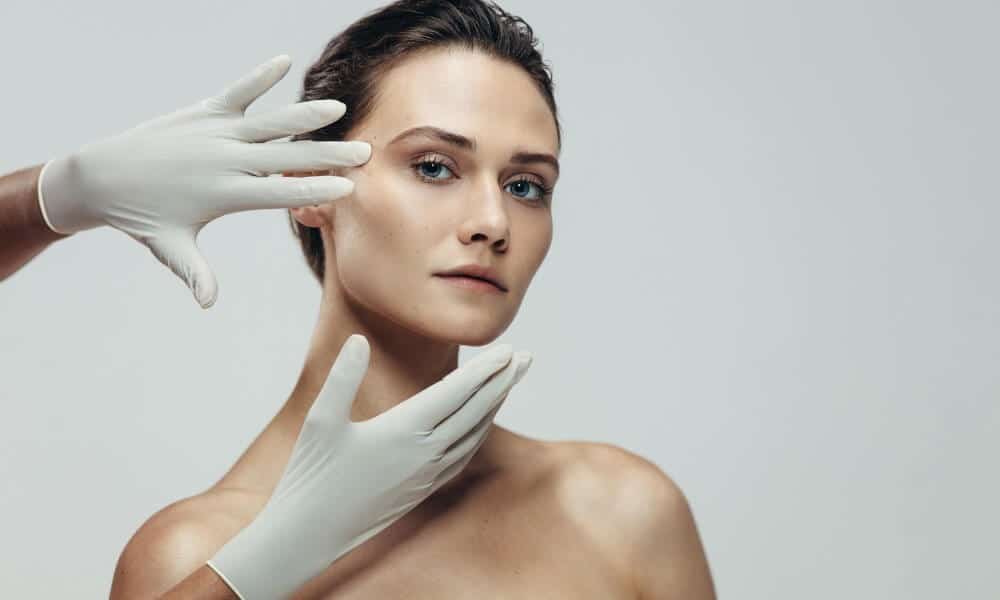
An eyelid surgeon determines ideal candidates for eyelid surgery through consultation, physical examination, photos, and the patient’s goals.
The journey to determine if you’re suited for eyelid surgery isn’t a hasty one. Us surgeons adopt a methodical approach, which often includes a detailed consultation, physical evaluation, reviewing photographs, and understanding a patient’s desired outcomes. By doing so, they can make informed decisions about a person’s suitability for the procedure.
It’s vital to determine if you’re a suitable candidate for the procedure. Here’s a breakdown to guide you:
1. Initial Consultation
This is the stepping stone to any surgical procedure. An experienced surgeon will delve into your medical history and present conditions. Expect questions about past surgeries, existing medical conditions, allergies, and your usage of medications, tobacco, and alcohol. It’s also essential to clarify your expectations from the surgery. Based on this conversation, the surgeon can recommend the most suitable procedures to achieve your desired results. If all aligns well, the next steps toward the surgery can be scheduled.
2. Medical Assessment
Before proceeding, a comprehensive physical examination is necessary. This might include measurements of your eyelids, checking tear production, and a detailed eye examination, including peripheral vision tests. If there are any medical concerns from this assessment, the surgery might need to be postponed or modified.
If you pass the physical examination, you can proceed to surgery.
3. Photographic Documentation
Having photographic records is vital. It provides a reference for both the surgeon and patient. Multiple angles of your eyes will be captured to help with planning and evaluating the surgical outcomes. These images can also be beneficial for insurance purposes.
4. Understanding Your Aims
The primary purpose of the surgery should align with what the procedure can realistically achieve. While eyelid surgery can enhance one’s appearance, expecting perfection might lead to disappointment. If you have multifaceted goals, the surgeon might suggest supplementary procedures.
Preparation for Eyelid Enhancement Surgery
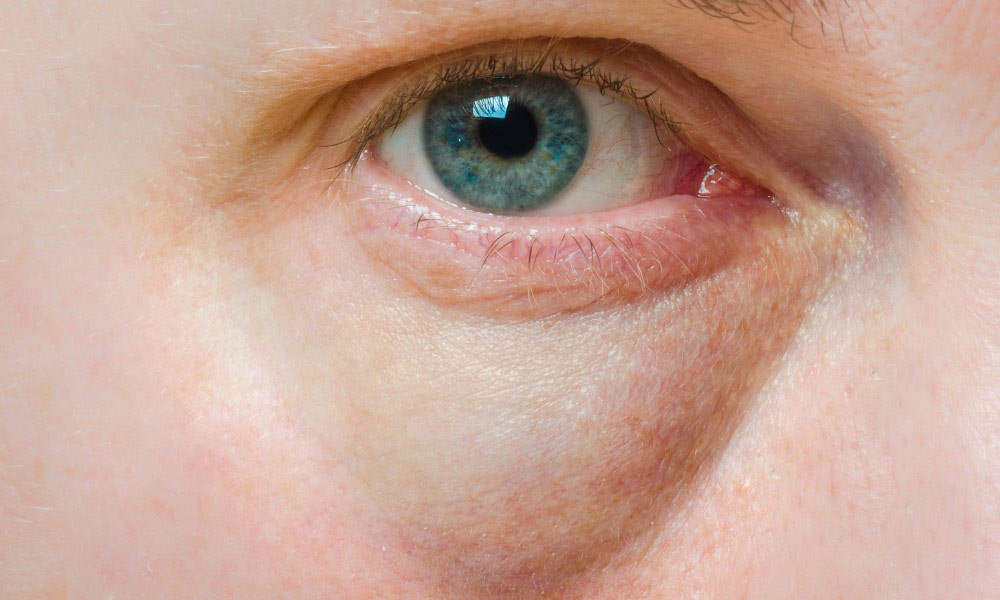
You need to do certain things to qualify for eye lifting surgery.
Medication Guidelines: It’s advisable to avoid certain medications, like aspirin or ibuprofen, known to amplify bleeding risks, about a week or two pre and post-surgery.
Lifestyle Choices: Hold off on tobacco and alcohol for a couple of weeks before and after the procedure. These can hamper the healing process and may introduce complications.
Dietary Considerations: Reduce salt intake to prevent excessive water retention which might interfere with the surgery’s results. Staying hydrated is also key, but ensure the water intake is consistent.
Timing: Opt for the surgery when in optimal health and ensure your schedule allows ample recovery time.
Weight: Aim to be at a stable weight before the surgery, which ensures optimal skin tightening results.
Logistics: Plan transportation for the surgery day and consider having someone to assist you post-surgery, especially on the first night back home.
Visit Julian de Silva – Cosmetic Surgeon, London
Considering eyelid surgery in London? I, Dr. Julian De Silva, welcome you to my Harley Street Clinic. Schedule a detailed consultation with me now to understand how we can help you achieve your aesthetic goals.

